Today, people know about more than 6000 planets outside the solar system. But among them, the most interesting are those that could become our new home. Unfortunately, it is impossible to accurately assess which of the alien worlds offers the best environment for human life. So we have selected 10 that, according to scientists, have the closest conditions to Earth.
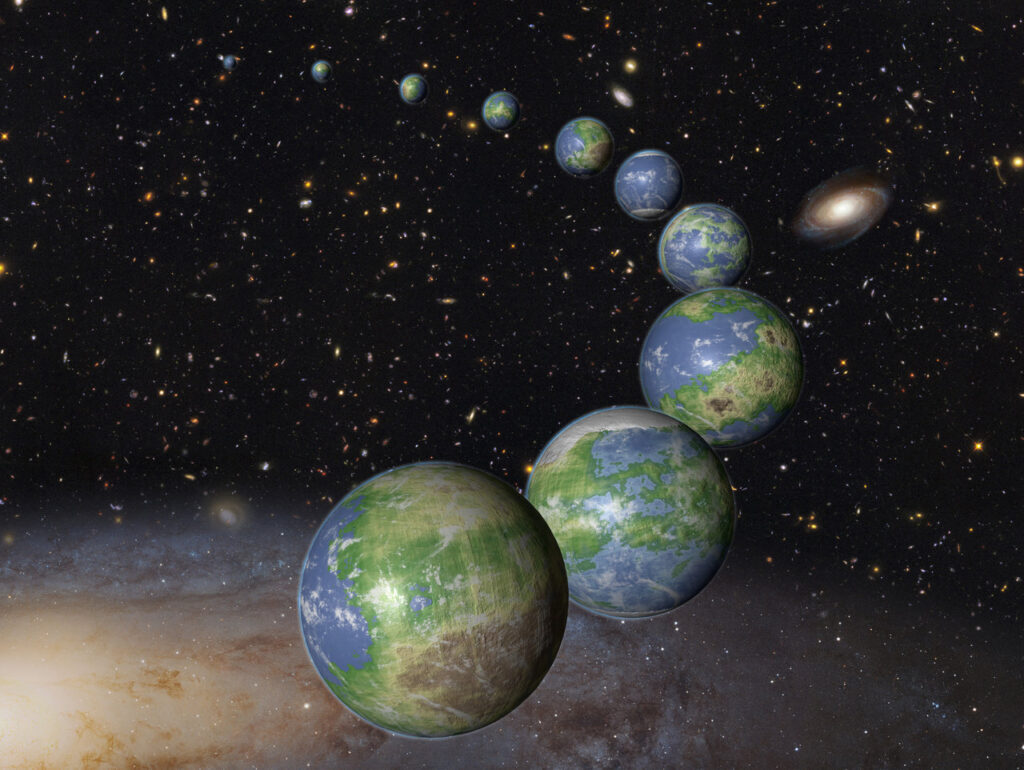
What is an “Earth-like planet”?
One of our readers asked us this question:
Which exoplanet in the Milky Way galaxy is the most habitable for humans?
Yuriy.
Yuriy’s question is not as simple as it may seem. As of July 2024, people know of 6911 confirmed exoplanets. Several thousand more are still considered candidates, i.e. not confirmed. But all of this is only a small fraction of the worlds that are estimated to exist in the Milky Way galaxy.
Therefore, if we talk about the planets that are best suited for human existence, we should add “of those whose existence has been proven by Earth science.” With this formulation of the question, we have one planet that is the best for human life.
We are talking about the Earth. Humanity appeared here in the process of biological evolution. Therefore, our bodies are maximally adapted to exist in earthly conditions. So, our planet is the standard against which we compare all the others.
And I must say that most of the confirmed exoplanets are not at all like Earth. They are either too hot or too cold gas giants. The conditions on them absolutely do not allow for the existence of people outside of a spacesuit or station. So we need to search among a much smaller sample of rocky bodies.
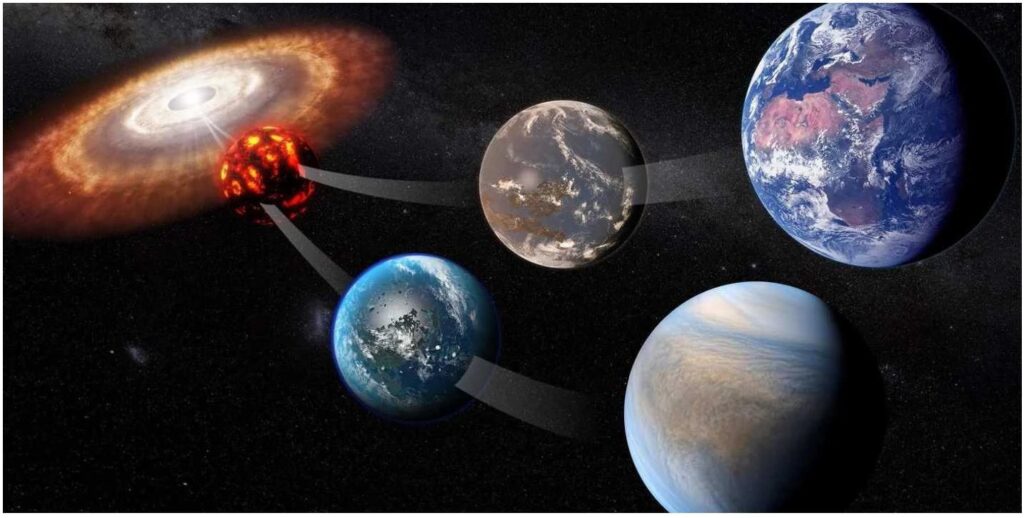
And then the question arises what do words “Earth-like” exactly mean. The fact is that the mass and chemical composition, temperature and the presence of liquid water and oxygen atmosphere may differ from Earth’s in a pretty wide range. One of the best ways to assess the potential habitability of a planet is the Earth Similarity Index (ESI), proposed in 2011. It is a function of the planet’s mass, density, and temperature and is measured in values from 0 to 1.
This approach allows us to accurately assess gravity and relatively accurately — temperature and chemical composition. The problem is that the ESI does not take the greenhouse effect into consideration and, in general, the thermal effects that occur in the planet’s atmosphere and hydrosphere. After all, we still can’t detect these phenomena at distances measured in light years.
Therefore, ESI is very poor at distinguishing between Earth and Venus if they are not in the same star system as the observer. Nevertheless, it can still be used to identify the ten most Earth-like exoplanets.
1. Teegarden b
The most Earth-like exoplanet is Teegarden b. It gets its name from the Teegarden Star, and the latter — from astronomer Bonnard Teegarden, who led the search program that discovered this tiny 8 billion-year-old luminary in 2003.
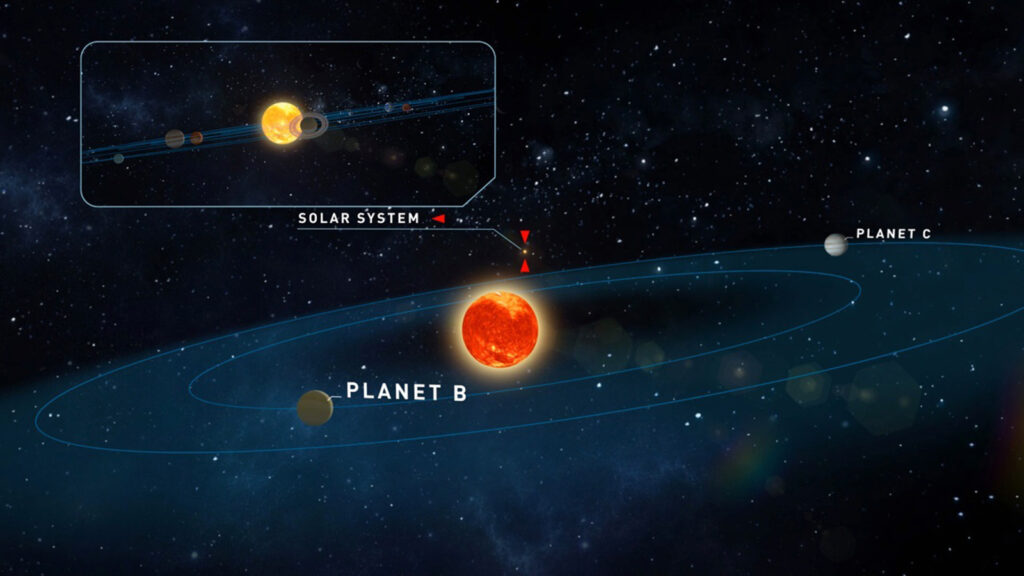
Teegarden’s Star is a dim red dwarf. It is located at a distance of only 12.5 light-years from us in the constellation Aries. The mass of this tiny star is only 7% of the Sun’s, its radius is 10 times smaller than that of our own luminary, and its luminosity is about 12 thousand times less than that of the Sun.
However, in 2019, a planet was discovered near this star. The mass of Teegarden b is only 5% greater than the Earth’s, the radius is measured very roughly, but it is also very similar to that of our planet. The average temperature on the surface is estimated at 28°C. This is slightly higher than on Earth, but there is a chance that the greenhouse effect has not turned this world into a Venus-like hell.
The problem is different: Teegarden b makes one revolution around its star in 4.91 Earth days. The planet is tidally entrained, meaning that the same hemisphere is always facing the star. This raises the question of whether the atmosphere and hydrosphere can provide an even climate on it. It is also uncertain whether its magnetic field is capable of providing reliable protection against high-energy particles, especially during starbursts.
2. TOI-700 d
TOI-700 d is the most distant of the three planets in the system, discovered in 2020. The star TOI-700 itself is located at a distance of 101.4 light-years from us in the Dorado constellation. It is a relatively young and massive red dwarf with a mass and radius of about 40% of the Sun’s.

TOI-700 d has an orbital radius of 0.163 AU and makes one revolution around the star in just 37 days. But because the star itself is much dimmer than the Sun, the planet receives only 86% of the light from it that the Earth receives from the Sun. As a result, the temperature on the surface should be about -4°C.
The mass of TOI-700 d is 72% and the radius is 14% larger than that of the Earth. The contribution of the greenhouse effect is unknown. However, it is likely to be a rather cold, though not completely ice-covered world with a significantly higher gravity than on Earth.
Given the small age of the system and the considerable distance to the star, the planet should not have had time to synchronize its rotation and become tidally trapped. However, its age of 1.5 billion years may also mean that there may not be any life capable of supporting an oxygenated atmosphere.
But the star TOI-700 does not show the powerful outbursts characteristic of smaller red dwarfs. And this greatly increases the likelihood of preserving the planet’s atmosphere, oceans, and life.
3. Kepler-1649c
Kepler-1649c is a planet orbiting a red dwarf located at a distance of 301 light-years from us in the constellation Cygnus. It was discovered in 2020. The planet’s parent star is 5 times smaller in mass and 4 times smaller in radius than the Sun. Therefore, although the planet makes one revolution around it in only 19 Earth days, it receives only 75 percent of the light that the Earth has.
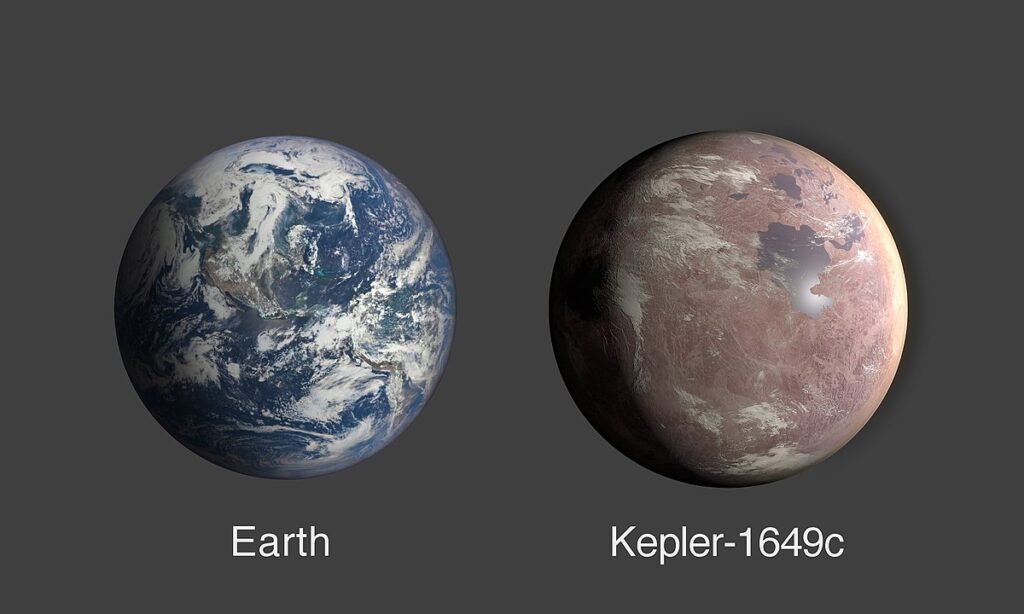
As a result, the average temperature on the planet is only -39°C. Perhaps the greenhouse effect makes it a little warmer, but we can’t say for sure. The radius of Kepler-1649c is 6% larger and its mass is 20% larger than the Earth’s, so the gravity there should feel quite comfortable for us.
Most likely, Kepler-1649c has the same problems as Teagarden b. It is tidally trapped and suffers devastating flares from its star.
4. TRAPPIST-1 d
In 2016, the discovery of TRAPPIST-1 stirred up a lot of excitement. After all, this system contained 7 planets similar in size to the Earth, and three of them were in the “habitable zone”. However, scientists are most interested in TRAPPIST-1 d.
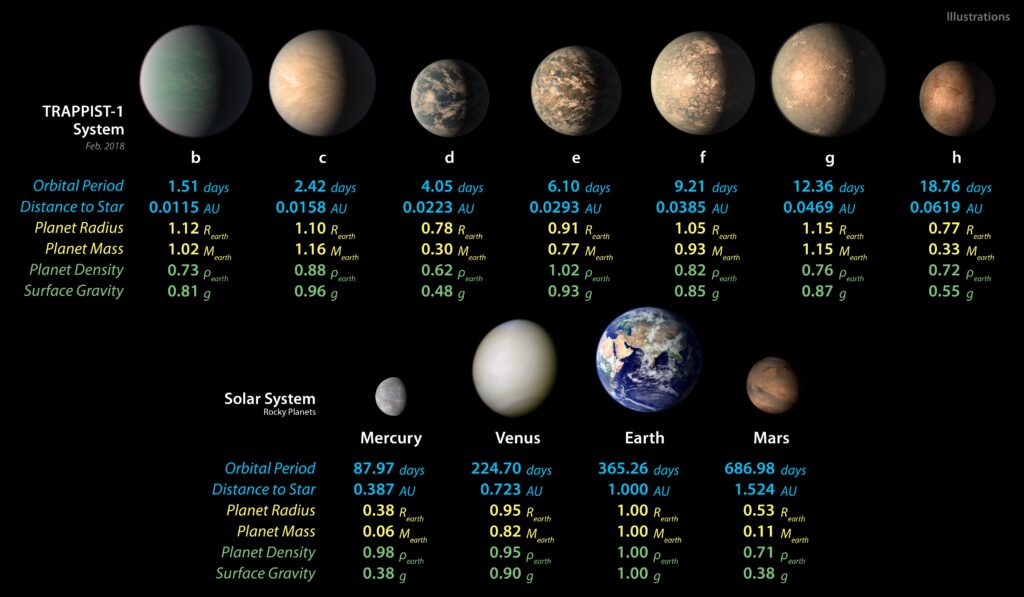
The star TRAPPIST-1 itself, located at a distance of 39.5 light-years from us, is another red dwarf, whose luminosity is a thousandth of the solar one. Therefore, all 7 planets are located very close to it. Specifically, the planet d makes one revolution in 4 Earth days.
The radius of TRAPPIST-1 d is 77%, and its mass is 33% of the Earth’s. That is, in terms of gravity, it is a cross between the Earth and Mars. As for its temperature, scientists believe that it is about 15°C, excluding the greenhouse effect.
For comparison, the average temperature on our planet on the hottest day in July 2024 was 17.09°C. This means that this body may be the closest to Earth in terms of its temperature conditions. But only if it does not completely lose its atmosphere and hydrosphere. And this is quite possible, given its low mass and the fact that the star TRAPPIST-1, like all red dwarfs, often flares up.
5. Proxy Centauri b
The closest exoplanet to us, Proxima Centauri b, is also one of the most Earth-like. The red dwarf around which it orbits is located at a distance of only 4.22 light-years from us. As in the case of all such objects, this luminary produces thousands of times less light than the Sun, meanwhile generating strong flares.
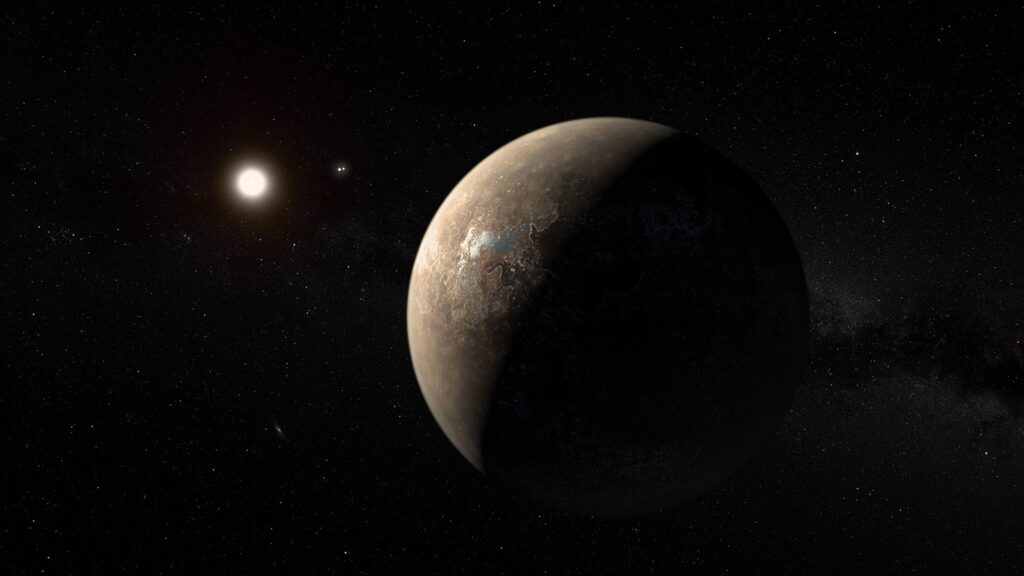
The orbit of Proxima Centauri b has a radius of only 0.05 AU, and it makes one revolution in 11 days. From its star, Proxima Centauri b receives only 65% of the energy that the Earth receives from the Sun. This allows its surface to be heated only to -39°C. Of course, this is very cold, and we can only hope for the greenhouse effect to warm it up further.
The planet’s mass is 17% and its radius is 10% larger than that of the Earth. The planet is tidally trapped.
6. K2-72 e
K2-72 e is another member of the multi-planet red dwarf system. This world was discovered in 2016. It is located at a distance of 215 light-years from us in the constellation Aquarius. In addition to it, three other large bodies orbit the faint star.
The planet makes one revolution around the star in 24 days, and the temperature on its surface, excluding the greenhouse effect, should be -12 °C. That is, it is significantly colder than the Earth, but it should still not be completely covered with ice.
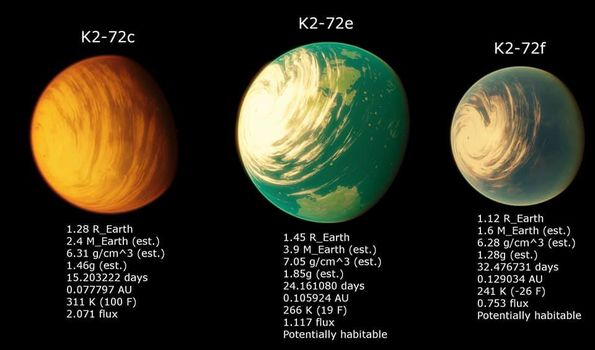
K2-72 e and its neighbors. Source: www.facebook.com/Siankaan.Astronomia.UAM
The mass of the planet is 2.21 times and the radius is 1.29 times larger than the Earth’s, meaning that it is significantly larger than all the previous ones and may have a powerful atmosphere and hydrosphere. The situation with tidal entrainment is not fully understood, nor is the extent to which its star is active in terms of outbursts.
7. GJ 1061 d
The planet GJ 1061 d is located at a distance of 12 light-years from us in the Horologium constellation. It orbits a red dwarf whose mass is only 11% of the Sun’s, along with two others.
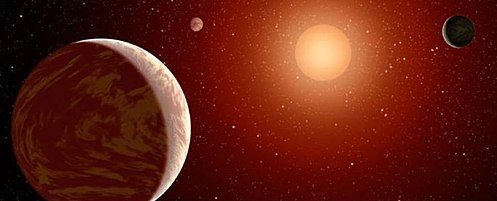
The average distance of the planet from its star is 0.059 AU, and it makes one revolution in 13 Earth days. At the same time, its orbit is very eccentric, i.e. elongated. The average temperature on the surface is -23 °C, and its mass is 64% higher than that of the Earth.
8. Ross 128b
Ross 128b is an exoplanet located at a distance of 11 light-years from us. Like the other worlds on this list, it orbits a red dwarf. One year on it is only 10 Earth days.
The planet’s mass is 40% greater than that of the Earth, and its radius is at least 10% larger than that of our planet. There are different estimates for the temperature. However, if Ross 128b has the same albedo as the Earth, it should be 7°C.
9. Luyten b
The planet Luyten b orbits a red dwarf known as Luyten’s Star, located 12.2 light-years away in the constellation of Canis Minor. It makes one revolution around the star in 18.6 Earth days.
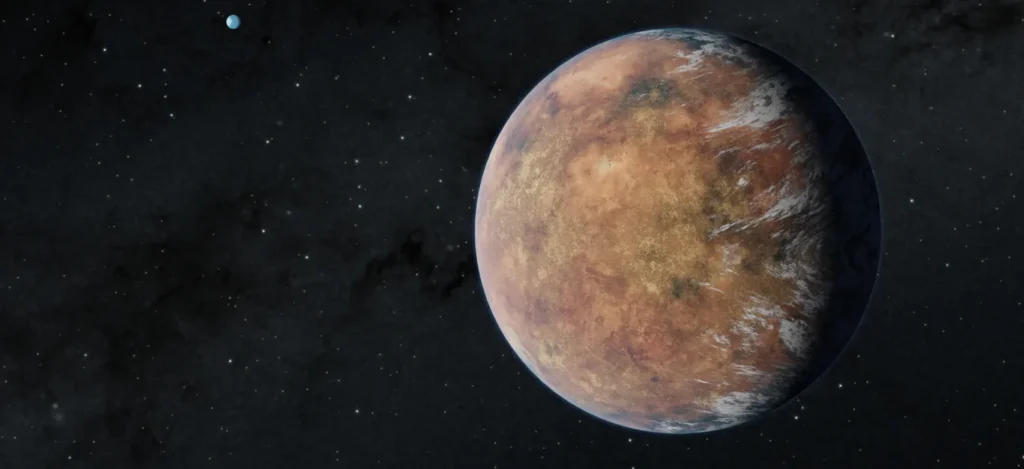
The temperature on the planet’s surface, excluding the greenhouse effect, is -14°C. The planet’s mass is 2.89 times that of the Earth, and its radius is 51% larger than that of our own world.
10. TRAPPIST-1 e
TRAPPIST-1 e is located in the same system as TRAPPIST-1 d, but its orbit is farther from the star. It makes one revolution in 6.1 days. Unlike its neighbor, it is much larger.
TRAPPIST-1 e has a radius of 92% of the Earth’s and a mass of 77%. The temperature on the surface is -22 °C.


